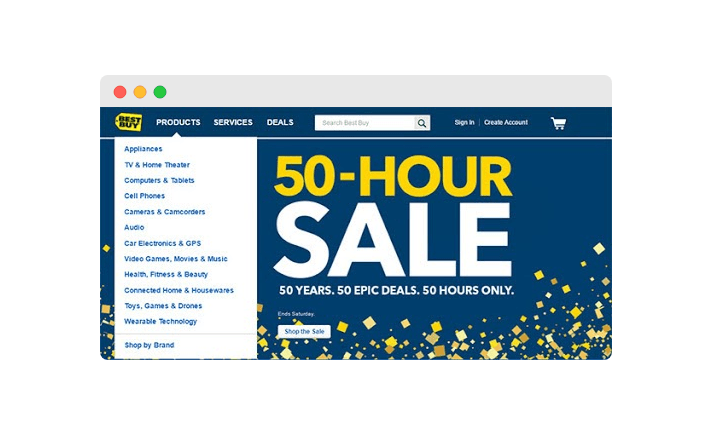On-site search is more than just a search bar at the top of your website, it’s an essential part of navigation, a vital part of how users interact with your organization.
“85% of consumers say that it’s important to them to be able to resolve issues without contacting the company.” Indeed, many web visitors rely on search to find the information they’re seeking, and a good search experience can make or break a user’s experience. Nowadays, users expect search to work perfectly so your on-site search needs to deliver relevant results or visitors will be more likely to leave your site and you’ll lose prospective customers.
So how do you ensure your on-site search performs well and helps your organization convert visitors into customers or help your existing clients get the answers they are looking for? We’ve gathered a list of tips to help you make the most of this underrated tool.
What is on-site search?
Site search is the internal search functionality on a website. It enables users to search a given website’s content or product catalogs with speed and relevance.
Search begins when a user expresses a need as a query, typically looking for an item or specific information. The website search engine then gives its response as a set of results and the search experience ends when the user has found what they’re looking for.
Why is site search important?
Search websites like Google or YouTube have become an integral part of our Internet experience. So it’s not surprising that web visitors expect the same level of ease and speed when it comes to searching individual websites for products, content, or information.
Search bars are an essential part of any website functionality and design nowadays, but site search often goes unnoticed unless it fails. When you consider the fact that 30% of web visitors perform a search, and that visitors who use search are 3 times as likely to find what they are looking for and convert into customers or leads than users that simply browse, you understand the importance of implementing a tool that can deliver the best search experience possible for your users, so they’ll never get the dreaded ‘0-results’ page or hundreds of irrelevant results.
Benefits of a quality on-site search
There are many benefits to providing a quality site search experience, including the ability to:
Deliver relevant results
This is the obvious primary goal of a quality site search. Driven by artificial intelligence, it ensures that impactful search results are found for any given search term.
Enhance the user journey
A site can have awesome content or phenomenal products, but if users can’t find it, they’re likely to be frustrated. Providing relevant results is a great way to enhance the user experience, especially if your website content is dense or your navigation complex. Site search offers an efficient alternative to sifting through numerous web pages, and allowing users to filter results, browse different categories of content, and even recommend related and popular searches will lead to happy visitors.
Reduce bounce rate
Research shows that 12% of website visitors will leave and opt for a competitor’s site after an unsatisfactory search. Don’t drive your visitors away! Offering a fantastic search experience will ensure you not only keep your visitors, but also attract your competition ones.
Increase conversions
When you help visitors find what they’re seeking the first time around, it has a dramatic impact on sales and engagement. By delivering relevant search results and a painless user experience, your visitors will be more inclined to stay on your website, keep on browsing, and ultimately take action.
Learn from your site search
Each time a user searches your site, they generate valuable user intent data. Analytics from your site search are an incredible resource when it comes to learning your users’ needs and intentions, as they’re telling you their desires in their own words. Monitoring your site search analytics on a regular basis will enable you to:
- Discover search trends
- Identify ineffective searches
- Identify and fill in content gaps
- Understand your users better
- Optimize your results
Enhance your SEO efforts
Effective site search improves the overall UX of your website, which is something Google values when ranking sites. Site search also requires a logical, hierarchical organization of content, which helps search engines like Google understand your core topics and products.
How to implement site search
There are three ways to launch your site search:
Build it in-house
This is the most expensive and time-consuming option. Building your on-site search engine in-house has the advantage to give you full control over its technology and functionality, but requires you to personally maintain it, which can become a massive (and costly) burden over time.
Use your CMS’ built-in search
When it comes to CMS search, you get what you pay for. While it’s a cost-effective option, the search is often very simple and not very functional.
Purchase a dedicated search solution from a 3rd-party vendor
Choosing to work with a 3rd-party vendor provides you with an “out-of-the-box” experience. Simple implementation, ample features, and quality support make this the most comprehensive option. Purchasing an on-site search solution such as Inbenta’s semantic Search engine is a clever choice that will ensure you get a tool that’s optimized to your needs and that doesn’t leave your visitors frustrated.
Which functionalities to look for in a site search
Analytics
Many site search benefits can’t be realized without a site search equipped with analytics capabilities. Make sure the platform you choose enables you to understand your visitors and constantly refine your site.
Semantic search using NLP technology
Unlike lexical search, which only looks for literal matches for query words and will only return results when a keyword is matched, semantic search understands the overall meaning of a query, the intent behind the words.
Because we’ve all been conditioned by Google, we now expect search experiences to always be as smart. If your website’s search tool fails to meet these expectations, don’t be surprised if your visitors abandon the search and leave your site.
When choosing a site search, it is of the utmost importance to ensure that the solution you choose has the capability to understand human language. Inbenta’s Search module is powered by Symbolic AI and Natural Language Processing technology, which enables it to understand the meaning of users’ questions regardless of slang, jargon, and spelling.
Auto-complete
Auto-complete is a mechanism that provides suggestions in a menu below the search when users are typing their query. Predictions can be tailored to your site’s specific content, to common keywords, or keywords from search history for example. But don’t overwhelm users with a high number of suggestions, 1 to 10 is usually enough.
This mechanism isn’t about speeding up the search process, but rather about guiding the user and helping them in constructing their search query as most users are very poor at query formulation: if they don’t get good results on the first try, they can easily give up and leave your site. So providing this functionality ensures that the user experience is facilitated and seamless.
Faceted search
Commonly viewed as a type of filtering, faceted search is a search feature that allows users to refine the search results thanks to facets. Facets are the checkboxes, dropdown menus or fields usually presented on top or on the side of the search results in order for users to refine their query.
Someone searching for “men’s shirts” for example is likely to want to narrow results down with facet filters such as color, size, price range, and so on. Faceted search provides the ability for users to quickly do so. By eliminating the need for users to scroll through seemingly endless results, it decreases the time required for users to find what they want, promoting a better user experience and higher chances of conversions.
Federated search
Federated search indexes information from various sources such as documents, internal knowledge base, FAQs, external website, etc, and unifies them under one main search engine.
The search application is usually built on top of other search engine(s), retrieves information from a variety of sources, and presents it in one common interface for users to browse. When the user types a query, the federated search engine simultaneously browses multiple and disparate databases, returning content from all sources in a unique interface.
This functionality is particularly useful in complex organizations with thousands of sources of information in the cloud and on-premise. It encourages users to go beyond what they were originally searching for and enables organizations to collect valuable data about popular products for example.
On-Site Search design best practices
Place the search bar in an expected location
Users shouldn’t have to look for your search function. Placing the search bar in either the top-right or top-center of the web page ensures the search functionality is visible and readily available for those who need it. That’s where users expect it to be.

If your users cannot find the content that they are looking for, it’s likely they’ll want to conduct searches on other pages than your homepage. This is why you should also provide access to the search box on every page, ensuring they can use your search from any site location. It’s especially important to provide a search box on 404 pages.
Use a magnifying-glass icon
Your search box should always display a magnifying-glass icon. This specific icon is a widespread symbol of search and has a universal recognition from users, so we recommend you place it in your interface as it saves space and is identified more quickly than text.

You can place it either on the search button or directly inside the search box.
Include a text field and a search button
Most search bars consist of two elements: the search box, where users write their queries, and a search button, which users click to initiate a search. These elements are most often placed horizontally adjacent on a single line.
The search box should be just that, a box where users input a text. The search button helps users understand that there’s an additional step to trigger the search action, hence why we recommend including one.

Size your search bar appropriately
The size of your search bar will depend on its importance on your site and the expected length of a typical query. Making the input field too short is a common mistake as only a portion of the text is visible, which means bad usability since it becomes hard for users to review and edit easily their query.

A rule of thumb is to have a 27-character text input as it would accommodate 90% of queries.
You now have all the knowledge to build the best site search possible, you’re only missing a great tool. Find out how Inbenta Semantic Search module can help your organization achieve success thanks to our patented and proprietary technology.










